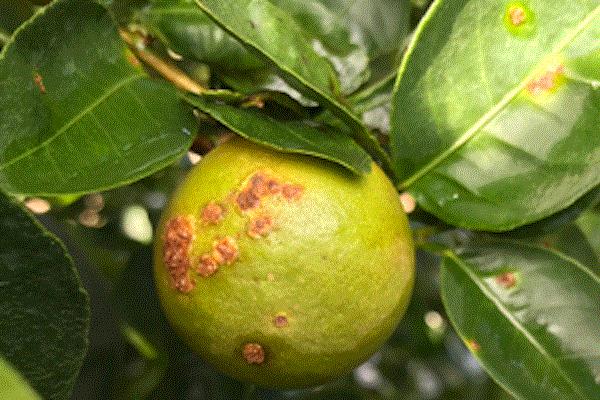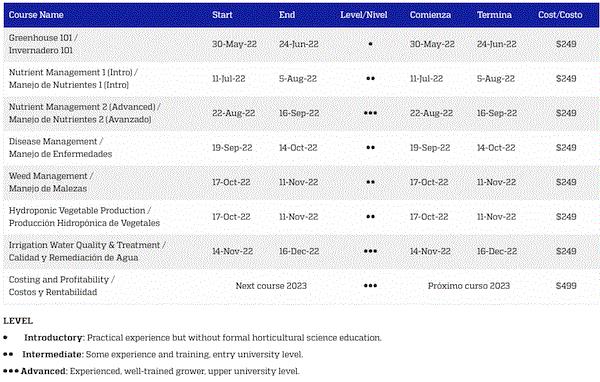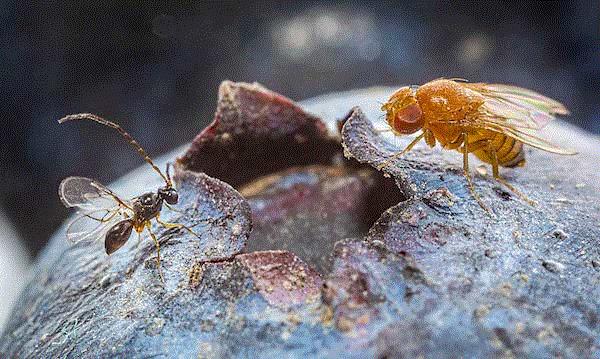Citrus Canker Found in SC Nursery
USDA-APHIS announced on March 9 that it confirmed the presence of citrus canker disease in a nursery in South Carolina. The nursery specializes in online sales of citrus plants directly to individual buyers. So far APHIS has traced forward potentially infected plants to buyers in 11 states: Alabama, California, Florida, Georgia, Louisiana, Mississippi, Nevada, Oregon, South Carolina, Texas and Washington. No nursery has received infected plants.
APHIS is working with state regulators to recall and destroy plants purchased from this nursery between August 5, 2021, and February 17, 2022, and eradicate the disease in the affected nursery. There's no word on how the infection started in the nursery.
This news is undoubtedly alarming to growers and regulators in citrus-producing states, particularly Arizona, California, Florida and Texas, who together produce just about all the citrus fruits harvested in the United States. Citrus canker is already found throughout Florida, and in parts of Alabama, Louisiana and Texas.
Citrus canker is a bacterial disease that can affect all citrus species and varieties. Infection causes lesions on fruits, stems and leaves. Infected leaves and fruits also drop prematurely. Although the infected fruits look ugly and unmarketable as fresh fruits, they're perfectly edible and harmless to people. (Look at me—I’m still kicking and causing trouble.) Find out more about citrus canker by clicking HERE.

Citrus canker causes lesions on fruits and leaves. (Photo credit: USDA-APHIS.)
If you’re one of the folks who bought (online) a citrus plant from a nursery in South Carolina between August 5, 2021, and February 17, 2022, please contact your local APHIS office. Contact information can be found HERE.
I was intimately acquainted with citrus canker when I was a post-doctoral researcher working in South Florida 15 years ago. (For those who don’t know, post-doctoral fellowship is the period between having earned your Ph.D. degree and getting a real paying job. I enjoyed my time as a post-doc—no worries about classes, term papers, grant money, reports, committee duties, annual evaluation. Just do fun research.)
What struck me then (and now) wasn’t how devastating citrus canker was, but how bitter regular folks were about the eradication program. The citrus canker eradication program from 2000 to 2006 involved removing every citrus tree (infected and healthy, big and small) within 1,900 ft. of a canker-infected tree; no question asked, no protest.
The heavy-handedness created resentment, so much so that when I was helping out in a statewide survey of Asian citrus psyllid and huanglongbing (another devastating disease of citrus) in 2006, these otherwise sweet grandmothers fiercely forbade me from approaching their sour orange, lemon or grapefruit trees. I was issued an umbrella so that when someone releases a dog at me, I can open the umbrella, confuse the dog and buy myself a chance to get away. Luckily, I never had to defend myself that way or yelled out in my Malaysia/English-accented Spanish, “¡Quítame la chihuahua de encima!”
The eradication program ultimately failed to achieve its goal of protecting Florida’s citrus industry from citrus canker. Folks sued the state of Florida and won a settlement in 2018. Perhaps having learned the lesson, the same scorched-earth approach wasn’t employed by the Fed and the state for the huanglongbing quarantine program.

Bayer to Sell Environmental Science Unit to Cinven
After months of guessing and rumors, we now know who the new owner of Bayer’s Environmental Science business will be. Bayer announced on March 10 the sale of its Environmental Science unit to Cinven for a price tag of $2.6 billion.
We know Bayer Environmental Science. This is the part of the gigantic corporation that brings us some of the most well-known pesticides, such as Aliette, Altus, Broadform, Kontos, Marengo, Merit and Ronstar. But the unit is so much more than that. In addition to the turf and ornamentals market, it provides pest management solutions to pest control, vegetation management and forestry.
Who’s Cinven, you ask? I asked the same question. Good-ole Wikipedia tells me that Cinven is a global private equity firm based in London. So the talks about private equity taking over that had circulated since Bayer announced its divestment of the Environmental Science unit about a year ago actually panned out.
The divestment of the Environmental Science unit will allow Bayer AG to focus on its core agricultural business through its Crop Science division (which acquitted the trait technology of Monsanto in 2018). It’s not clear at this time how Cinven may reshape the Environmental Science unit, and how that eventually will impact the availability of products in and the technical support traditionally provided by the unit to our industry. In the short term, we can expect business as usual.

Marrone Bio to Merge With Bioceres Crop Solutions
After relocating its headquarters to Raleigh, North Carolina, in January, Marrone Bio Innovations announced on March 16 its merger with Argentina-based Bioceres Crop Solutions Corp. (Not to be confused with BioCeres the biological insecticide offered by BioSafe Systems. I know—I had to do a double take, too.)
Bioceres is a company with expertise in discovering, developing and commercializing biotech traits (such as its HB4 drought-tolerant soybean and wheat varieties), biofungicides, bio-stimulants, inoculants and other products that improve sustainability of agricultural production. Its brand of soybean inoculants allows the company to capture 23% of global share in the inoculant market.

Marrone Bio Innovations, on the other hand, is a company relatively well-known to our industry. This is a company that develops biological pesticides against weeds, pests and diseases, such as Grandevo, Regalia, Stargus and Venerate.
The merger will create a company with the goal of becoming a leader in the development and commercialization of sustainable agricultural products and solutions. The companies have operations in 46 countries, and the merger will open new avenues for the combined product line to reach Europe, North America, South America and beyond. The availability of products from Marrone Bio Innovations will not be affected after the merger.

UF to Offer Online Greenhouse Training Courses Again
The University of Florida IFAS Extension is once again providing an opportunity for growers and employees to further their education in greenhouse production, pest management and business. If we can’t find enough labor, perhaps we can make up the shortfall with team members who are well-trained and efficient.
The Online Greenhouse Training program is a series of online courses that are instructed in English and Spanish. Individual courses can be selected based on the participants’ skill or experience level. The first course, Greenhouse 101, starts May 30. Discount on the registration fee is available for groups of five or more.
Click HERE for more information and to register for the course.

SWD Parasitoids Approved for Release
Too bad I can’t really do that “dun, dun, duuun!” sound effect very well in writing for the last piece of news this week. That’ll probably be the sound effect used for introducing a tiny wasp that has been approved for release against the spotted-wing drosophila (SWD).
SWD has become one of the major pests of fruits across North America and Europe since its discovery in California in 2008. I haven’t had a good harvest of blueberries for several years now because of this little fruit fly. Instead of gallons of firm, juicy berries, all I had last year were berries with soft, rotting spots full of tiny maggots. Find more information about SWD HERE.

Wasp vs. fly—who's going to win? The wasp featured here is called Leptopilina japonica. A related species, Ganaspis brasiliensis, has been approved for release against the spotted-wing drosophila (SWD), a pest of small fruits. The quest for a biological control agent against SWD begun almost as soon as the invasive pest from Asia was discovered. Several parasitic wasp (AKA parasitoid) species of SWD have been identified after years of searches and research in Asia and throughout North America. (Photo credit: Warren Wong, University of British Columbia.)
APHIS has recently approved the mass rearing and release of one of these parasitoid species, Ganaspis brasiliensis. Another Asian parasitoid species, Leptopilina japonica, was also studied, but wasn’t approved for release because this species will attack other fruit fly species, including native species. The parasitoids parasitize maggots in the fruits using their super-long ovipositors.
Interestingly, researchers in the Pacific Northwest and British Columbia already found these parasitoids before the release was approved. How did the parasitoids get here before any effort of releasing them? I can only offer a shrug as an answer. To quote Dr. Ian Malcolm, “Life finds a way.” Researchers will continue to study how effective these parasitoids are at reducing the population of and damage by SWD.
Find more information about parasitoids of SWD HERE.




See y'all later!

JC Chong
Professor of Entomology at Clemson University
This e-mail received by 26,984 subscribers like you!
If you're interested in advertising on PestTalks contact Kim Brown ASAP!